On November 20th Djokovic won the ATP Finals. On January 1st 2023 he is slated to play the Adelaide International. That’s only forty-two days between seasons. It’s probably enough for Djokovic, who manages a lighter schedule throughout the year and is now one of the most technically sound players ever, but my focus is set more on youngsters. The off-season is a precious period that gives players an opportunity to make meaningful adjustments in their game without the pressure of competitive matchplay looming day-to-day. You can experiment with swing tweaks, put some miles in the legs, or even trial different racquet or string specs (with a new haircut).1 Given the lengthy time needed to ingrain a new swing pattern, racquet setup, or attain a better degree of fitness, it’s interesting to see so many players front up for what are essentially exhibitions in December.2 Of course, matches themselves can be valuable if you feel you are lacking them, but there is an argument that at some point, additional matches have little bearing other than acquiring experience and temporary match-toughness; most meaningful change occurs in training. These are the things that can really move the needle on performance in an era where players are playing more than ever with a hectic calendar. I mention Djokovic because his transformation as a player from the 2010 season, to the beginning of his famous 2011 run, was built on numerous such changes, the serve in particular I assume he worked on relentlessly in the weeks leading up to his famous win streak.
Djokovic 2011 - The Serve
Djokovic won his first grand slam at the Australian Open in 2008. He finished the year just as strong, winning his first World Tour Finals event. While his baseline game was often talked about, the Serb always had a sneaky good serve, and his 2008 season finished with 486 aces for just 153 double faults; a very healthy 3.18 aces to double-fault ratio. However, starting in 2009, Djokovic developed a kink in his backswing. The right arm straightened. The aces kept coming—502 of them in 2009—but double faults started to creep into his game. Things got even worse in 2010; he only hit 304 aces, yet the double faults blew out to 282. His baseline talent still earned him plenty of wins, but across 2009 and 2010 Djokovic went 7-12 against Federer and Nadal and didn’t win a slam. Below is Djokovic’s serve from the second-half of the 2010 season.

By the beginning of 2011 Djokovic had corrected the issue. Note below the smooth takeback. The racquet head glides past the back of his head with a bent elbow. You can also note that the toss is a little lower (which promotes fast swings). In 2011 Djokovic halved his double faults compared to the prior year (282 v 143). He also went 10-1 against Federer and Nadal (his only loss coming to Federer in the French Open semi-finals—unreal match—to snap his 42-match win streak). The GIF below is from Indian Wells in March 2011.
Observe below the position Djokovic was accelerating from in 2011 compared to 2010.


The Diet
While I tend to weigh technique quite heavily, none of it matters if you aren’t able to be in position, scampering around the court point-after-point, match after match. I think effective technique is more important with every additional ball hit. If you subscribe to the notion that all top 100 swings are effective, but some are more effective, then it takes many iterations of a particular shot to tease apart where those differences are, and it requires great footwork and fitness to be in position to leverage that difference if you are the technically superior player. Djokovic—in a bizarre diagnosis—went gluten free in 2010. An excerpt from his book, Serve to Win:
"Suddenly there was an X factor, a change in my diet that allowed my body to perform the way it was meant to."
Djokovic now eats like a man intent on living to 150, or I guess, playing well into his late thirties. He is reported to rarely drink anything besides room-temperature water. Whatever the reason for his incredible fitness turnaround in 2011, it helped lay the foundation for his technical proficiency to truly flourish. A quote from a prior piece on Djokovic’s technique:
“…but there is a cost to everything, and the cost is going to be consistency and accuracy.” The percentages are going to ever so slightly favour Djokovic, and it might not really pay off until the pressure rises, but when it does, these costs are amplified. The screams of frustration that bubble over after missing may convey a mental breakdown, but the origins of these ‘mental collapses’ are often baked into the technique.
We’ve seen numerous fitness transformations in an off-season pay immediate dividends for other players as well: Carlos Alcaraz is the most recent example. Lleyton Hewitt made the 2005 Australian Open final off the back of a bulked physique under Roger Rasheed, and Andy Murray early in his career realized he would need to get fitter to maximize his baseline game in the modern era.
The Racquet
I once heard rumours that Djokovic was using a shortened racquet at the Australian Open in 2011. I have no idea what his racquet length was in 2010 or prior, but a look on various databases (and in this YouTube clip here) suggests that the Serb’s stick post-2010 was indeed a couple mm’s under the standard 27 inches3. I'm not sure how much of a difference such a small tweak would make, but once again if it was a change he made in the 2010 off-season, it certainly didn't hurt his play in the new year and is in line with prior pieces I wrote on the notion of "control > power" and "remove to improve".4
Interestingly, the same year Djokovic allegedly made his switch to a shortened racquet, Federer echoed the exact difficulties of trying such a thing. A 2011 article from the New York Times (emphasis mine):
“I’ve tried bigger,” [head size] Federer said. “The problem is we don’t have enough time to do racket testing, you know? I’m always talking to Wilson about: ‘What else do you have? What else can we test?’ And who knows? Maybe down the road, I’ll change again.”
Federer eventually would change to a bigger racquet head (from a tiny 90 in. to 97 in.) and his newfound confidence in his topspin backhand was instrumental in winning three grand slams in 2017 and 2018. It’s also interesting that Federer’s brilliant 2017 Australian Open run (where he beat four top-10 players en route to the title, including a five-set win over Nadal in the final) came off the back of a six-month break due to injury. I’m not saying breaks due to injury are particularly helpful, but it does give a player plenty of time to reflect, experiment, tweak; things players probably don’t get to do in a regular season.5
More money, more matches, same player?
I’ve documented for months now certain technical flaws in several young players that could be addressed in an off-season. Interestingly, some of these players opted to play in the Diriyah Tennis Cup in Saudi Arabia for December:
Stefanos Tsitsipas’ slice backhand/chip return. He needs a more extreme (continental, rather than forehand) grip with more extension in the wrist, and I think he needs a bigger take-back on rally-ball slices. Watch this video and note that Tsitsipas' strings face skyward, rather than the back of his head like the great slices below6:
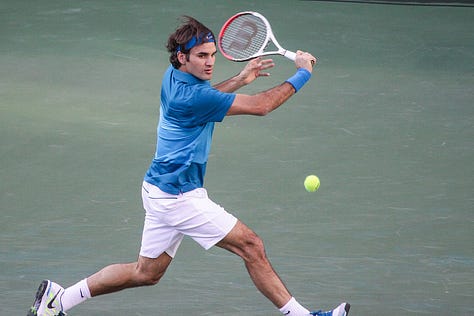
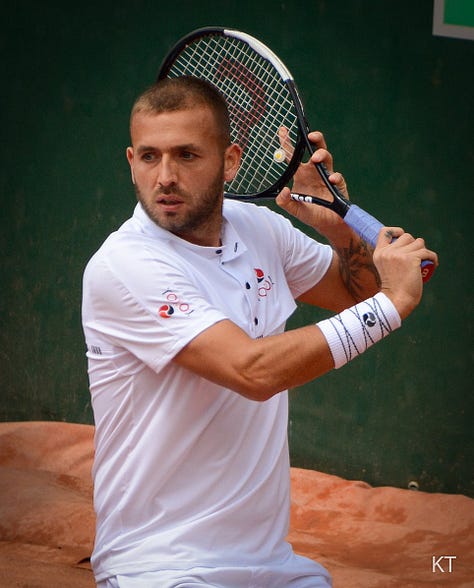

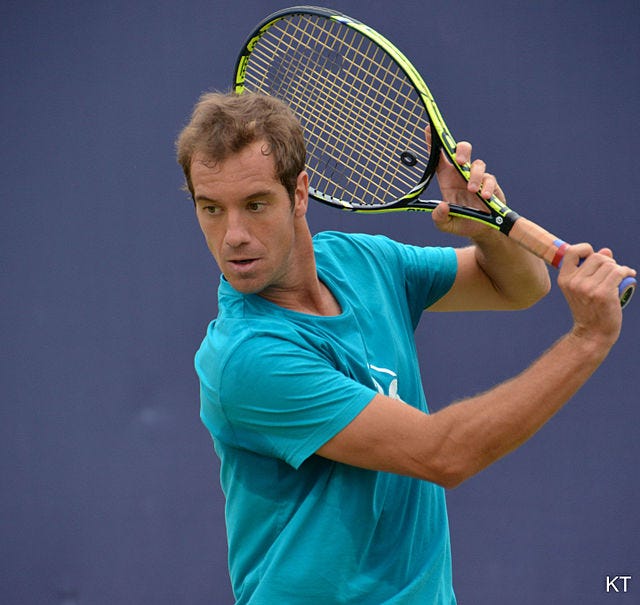
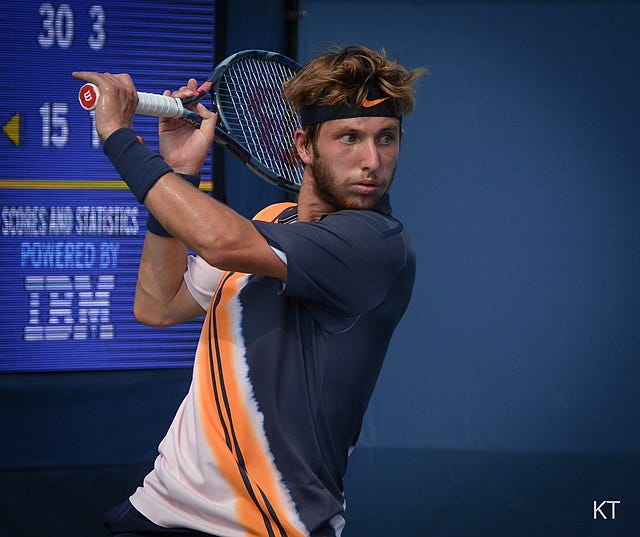
Matteo Berrettini’s two-handed backhand. That high left elbow away from the body, coupled with a closed racquet face is not ideal. He also lacks a proper drop underneath the ball.
Andrey Rublev’s backhand and slow second serve. Following his quarterfinal loss to Cilic at Roland Garros I wrote:
“Commentators noted that of the eight quarterfinalists (Nadal, Djokovic, Zverev, Alcaraz, Ruud, Rune, Rublev, and Cilic) Rublev had the slowest average second serve speed of 145km/h (Ruud had the fastest at 154km/h). Cilic was repeatedly allowed to take big swipes on second serves and he started many return points on the front foot.”
These are subtle changes in the set-up and execution—often moving the racquet head or hands only a few inches—to achieve a result that can dramatically improve a shot, which might end up moving the needle by 1%, in a sport where the most dominant player ever wins ~56% of points. These subtle degrees of difference, when applied to hundreds of shots over the course of a match, have a huge effect on who wins, and who loses.
Part of my belief is that at the elite level, technique plays an outsized role in success. While quantifying the relationship between technique and shot quality is never going to be a perfect science, the recent introduction of shot quality rating—a measure of each shot’s speed, spin, depth, width, and the impact it has on the opponent—by companies like Tennis Viz, is starting to provide some insight. If you’ve been reading this newsletter for some months, you’ll know I have picked on the backhands of Rublev, Tsitsipas, and Auger-Aliassime for poor technical elements. It was no surprise to see them lagging others at the ATP finals.
As I wrote after Rune’s win over Djokovic, where his coach, Lars Christensen, discussed the importance of technique at the elite level:
“if there are limits in those two things [balance and technique] they are going reach a certain level and they’re just going to plateau. It’s not going to be possible to take them any further.”
No amount of match play can correct the Auger-Aliassime/Rublev/Tsitsipas backhand issue; it can only improve how well they manage that shot (i.e., it is a plateau). Time dedicated in training to fundamentally change the backhand can instill a newfound degree of competence that results in a significant improvement, reflected in results, but also in shot quality metrics like the one shown above (as happened for Ruud).
Part of the greatness of the Big-3 was their willingness to change and improve swings/racquets/tactics in a bid to improve, even after they had achieved unfathomable success.
Nadal’s serve has undergone numerous iterations; at the 2010 US Open (which he won) he was regularly eclipsing 135mph partly due to a grip tweak. He’s also become a great slicer and volleyer as his career progressed, often choking up on the grip significantly to gain some control and maneuverability.

Djokovic changed his serve in 2011, and then also changed to a different racquet (longer, more open, and lighter) following elbow surgery ~2017. I think the longer racquet change later in his career also helped his serve speed. His game has become more serve-dominant and less reliant on returns as he has aged and lost a fraction of speed and consistency from the back. He also has developed a reliable slice that he used very effectively against Medvedev in the 2021 Australian Open final.
Federer upgraded to a bigger racquet head in 2013 and added—at times—the SABR, serve & volley under Edberg, and shortened his forehand as he got older. He also changed his serve to gain racquet head speed later in his career as explained by Joel Myers (highly recommend) in the 1-minute clip below.
A final quote from a prior piece:
“At its core, sport is about who can produce the most competent actions. Against the very best, you can ill-afford to have a technical weakness if you want to win grand slams and reach the pinnacle of the sport. Biomechanics matter.”
Not to mention getting some much-needed R&R.
Huge appearance fees are probably another driving factor. Makes more sense for someone like Nadal, who is lacking matches following injury, and toured South America with Casper Ruud for some exos.
Since elbow surgery ~2017, Djokovic now uses an extended-length racquet that is a little lighter and has a slightly more open string pattern.
A shorter racquet would have less power but be more maneuverable. Depends on playstyle, strokes, etc. Djokovic 2011 was an absolute wall and maybe a shorter racquet played a small part in that.
To make a counter-argument, it’s clear Casper Ruud made changes to his backhand technique during the 2022 season
Backhand slice photo credits. Roger Federer, Dan Evans, Grigor Dimitrov, Richard Gasquet, Corentin Moutet,
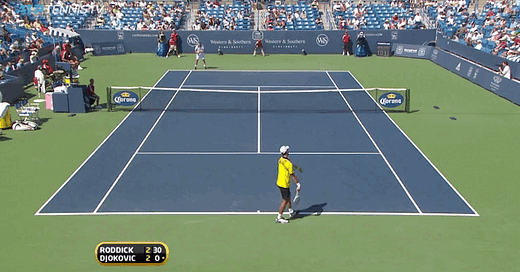




Great piece again and sheds some good light on a part of the tennis calendar that does not get enough attention (it doesn’t last very long either comparatively to other sports). Have you seen or heard of any notable changes yet that we can expect to see from the top pros in 2023?